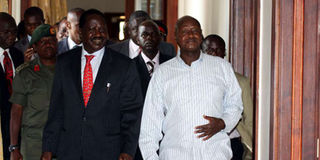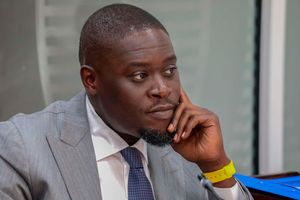Premium
Raila’s new movement echoes Museveni’s spirit of resistance

Nasa leader Raila Odinga (left), with Uganda’s President Yoweri Museveni. PHOTO | FILE | NATION MEDIA GROUP
What you need to know:
- Unlike Museveni’s NRM, Mr Odinga says National Resistance Movement will be non-violent, and will “embark on a national campaign of defiance of illegitimate governmental authority.
- Ever since he made his announcement, Mr Odinga’s critics — most of who hardly understand the concept of passive resistance — have been on his throat.
- That Mr Odinga is engaging in what Mahatma Gandhi would call “Satyagraha” is interesting.
Mr Raila Odinga’s National Super Alliance has metamorphosed into the National Resistance Movement (NRM) – perhaps borrowing the name from Yoweri Museveni’s political wagon that catapulted him to perpetual presidency in January 1986.
Unknown to many, Mr Museveni’s NRM was born in Nairobi in the house of a Ugandan exile, Christopher Mboijana, who was a business-ally of then Coast Provincial Commissioner Eliud Mahihu.
We will come back to that later.
But unlike Museveni’s NRM, Mr Odinga says his new outfit will be non-violent, and will “embark on a national campaign of defiance of illegitimate governmental authority and non-cooperation with all its organs”. The second aspect is to “boycott the goods and services offered by the businesses for whose benefit dictatorship is being established”.
Ever since he made his announcement, Mr Odinga’s critics — most of who hardly understand the concept of passive resistance — have been on his throat.
PASSIVE RESISTANCE
His fervent supporters have also defied his call for passive resistance and thwarted efforts by the Electoral and Boundaries Commission to conduct fresh Presidential elections, especially in Siaya, Migori, Homa Bay and Kisumu counties which have been called off.
That Mr Odinga is engaging in what Mahatma Gandhi would call “Satyagraha” is interesting. Louis Fischer, the Jewish-American journalist who became the Gandhi biographer, tell us in the book Life of Mahatma Gandhi that Satyagraha means “to be strong not with the strength of the brute but with the strength of the spark of God”.
How Mr Odinga will maintain this passive resistance campaign, once popularised by Gandhi in South Africa, is open to debate.
While his bitter critics have always said Mr Odinga advocates for violence, the former Prime Minister is perhaps mellowing with age and has of late avoided direct confrontation with police, leaving it to 66-year-old Siaya Senator James Orengo — whose gift of gab and militancy has always characterised his politics since his days as a student leader at the University of Nairobi.
FEARLESSNESS
Interestingly, it was Mr Odinga who asked his father, Jaramogi Oginga Odinga, to throw his weight behind Mr Orengo in 1980 — and as he says in his autobiography — having been “impressed by his fearlessness in confronting the administration in very repressive times.” Certainly a story for another day.
At the moment, there is very little likelihood that Mr Odinga’s NRM will follow the militant path of Mr Museveni’s NRM, although both have been born after a bitter electoral contest.
But there are several links that readers should know between Kenya, Uganda and the liberation movements.
While the formation of Mr Museveni’s NRM in Mr Mboijana’s house in Nairobi is little known, so is the contribution of Jaramogi to the earlier armed struggles to remove Idi Amin.
The story of Mr Mboijana, who later mysteriously died in London when he was Chairman of Uganda Airlines, is the story of a Ugandan businessman whose contribution to his country’s armed struggle is hardly talked about.
PARTNERSHIP
After he escaped to Kenya, Mr Mboijana became the managing director of Mr Mahihu’s African Safari Airways which was a joint partnership with Mr Karl Jacob Ruedin, the man who previously managed a Swiss Charter Company for billionaire Peter G. Staechilin.
Mr Staechelin had a story too. He was the son of a billionaire arts collector who had taken advantage of the First World War to purchase Van Gogh art collections and others by Picasso which he sold to support his airline. The airline was later brought down by a compensation case after one of the aircraft had an accident in Nicosia, Cyprus which was blamed on Ruedin, before he flew to Kenya to partner with Mahihu.
Mr Ruedin had the capital, Mahihu had the power and Mr Mboijana, who had fled the Idi Amin atrocities, had the management experience. The three met and established a chain of hotels and an airline. The rest is history.
The meeting in Nairobi — and the formation of NRM — took place a few days after Mr Museveni arrived in town while looking for a passage to Libya, after he was invited by President Muamar Gaddafi. The Libyan leader was willing to give Mr Museveni some arms to depose President Obote. Interestingly, the two – Mr Obote and Mr Gaddafi – were to meet in Nairobi for the OAU Summit of 1981.
MILTON OBOTE
In Nairobi, Mr Museveni had met Mr G.G. Kariuki and MMr Jeremiah Kiereini who advised him to leave since his presence would embarrass Mr Obote. As Mr Museveni would later put it in his biography, Sowing the Mustard Seed, “I had useful things to do than remain in the city with Obote.”
Some five years earlier, at the Hilton Hotel in Nairobi, Mr Museveni’s dream of ever getting to power had almost come a cropper. His activities in Nairobi had come to the attention of the Special Branch and Patrick Shaw, the deadly police reservist of the 1970s and 1980s, had been tracking him. At the Hilton, Mr Shaw was pretending to read a newspaper when their eyes met.
It was time to flee!
Mr Museveni asked the waiter to recharge their cups with more coffee and he got up “as if going for a short call... I turned the corner of Hilton, and took a taxi to Serena Hotel where I changed taxis and asked the driver to deliver me to the bus park where I took a Matatu to Namanga…”
FREEDOM FIGHTERS
His returned in 1981 with the full knowledge of government officials. Thus, it was at the house of Mr Mboijana that Mr Museveni and former Ugandan President Yusuf Lule met to draft the agreement that saw Lule’s Uganda Freedom Fighters (UFF), and Museveni’s ragtag militia, Popular Resistance Army, merge to form what is known as National Resistance Movement (NRM) with Prof Lule as its chairman.
The reason Mr Museveni was looking for Prof Lule, a former principal of Makerere University College, was because he had been unable to penetrate Buganda’s Luwero Triangle, which was crucial if he was to ever capture Kampala. In essence, he needed the Buganda support to succeed.
Prof Lule, to his credit, was part of a group that had in 1976 formed the Uganda Society in Nairobi and had also been elected the chairman of the Uganda National Liberation Front (UNLF) in Moshi Tanzania, a position that saw him become the first post-Amin president — though for only 68 days when he was replaced by Godfrey Binaisa.
FLOWER GIRL
It is now accepted that Prof Lule was only a flower girl, a puppet of other forces, and was only being used as a stepping stone by king-maker Paulo Muwanga – the man who in 1980 installed himself as the head of the Electoral Commission and declared Mr Obote’s Uganda People’s Congress the winner. It was after that election that Museveni protested and started a guerilla war in protest.
Previously, Jaramogi had opened his Opoda Farm to guerillas opposed to Mr Amin, the brute who had deposed President Obote — himself the brute who had deposed Uganda’s first President Sir Edward Mutesa in a palace coup.
As Mr Odinga writes in his autobiography, The Flame of Freedom, his father facilitated the movement of the likes of Mr Museveni and Brigadier Oyite Ojok, a UNLF leader, into Uganda. He writes: “Jaramogi’s cooperation was sought to facilitate their movement across the border to the eastern part of Uganda, and a channel was organised through which armed men moved clandestinely into Uganda from Tanzania.”
At times, Opoda farm would host “several hundred” of guerillas as they prepared to go and attack Tororo barracks. After Mr Amin’s fall, Mr Odinga made a trip to Uganda to see the devastation. “We had a glimpse of the difficulties that would be faced in rebuilding Uganda,” he writes. Later soldiers would give Mr Odinga and his cousin, Okach Ondiek, a four-wheel drive vehicle previously used by Mr Amin’s State research Bureau and they drove north to Lira.
DOOM
“Whenever we went, people ran to hide as soon as they caught sight of us. During Amin’s time, the presence of the Bureau vehicle had spelled doom. People were either shot on sight by Bureau assassins or driven away and never seen again,” reveals Mr Odinga in his book. While Mr Museveni’s NRM would manage to topple the government in Kampala, he would later be accused of training some Kenyans in guerilla warfare. One of the trainee is today a senior official in Mr Odinga’s Orange Democratic Movement.
Actually, when President Daniel Moi accused Mr Museveni of facilitating the traveling of Kenyans to Libya for military training while Museveni accused Kenya of hosting insurgents, there was some truth in it. This suspicion was heightened with the capture of Brigadier Smith Opon and Major John Olwo two former officers of Uganda National Liberation Army (UNLA) after they entered Uganda from Kenya.
Kenya was also accused of hosting Alice Lakwena, the Acholi “prophet” who was the leader of “Holy Spirit Mobile Forces” — which later became part of Joseph Kony’s militia — and who lived in Kenya until her death in 2007.
Kenya now has its own version of NRM and it will be interesting to watch how Mr Odinga will build a passive resistance movement. For political scientists and historians, these are interesting times.
[email protected] Twitter: @johnkamau1





